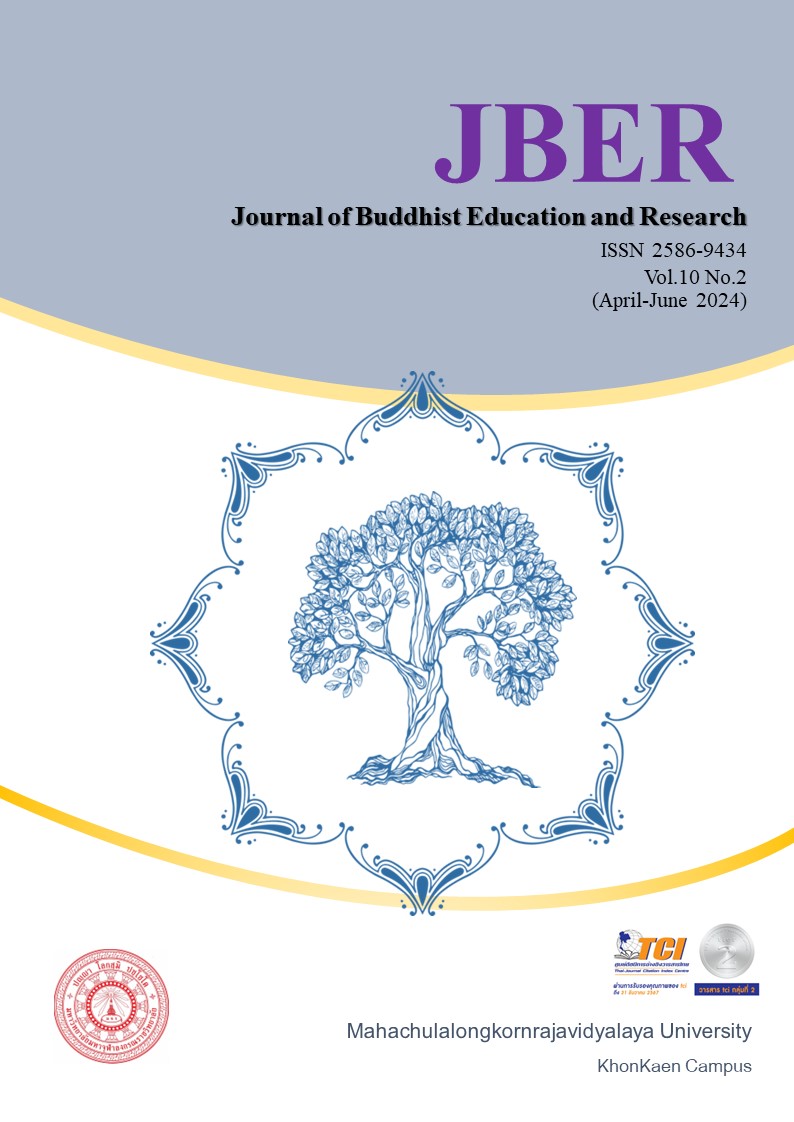LOKAPALADHAMMA: MANAGEMENT PRINCIPLES TO PREVENT CORRUPTION IN THAI SOCIETY IN A SUSTAINABLE MANNER
Keywords:
Lokapaladhamma, Management, principles to prevent corruptionAbstract
Corruption is the use of power acquired or misuse of existing assets. for the benefit of oneself, family, friends, acquaintances, or any other undue benefits which cause damage to the interests of others. Principles of Sustainable Corruption Prevention is to apply the principles of Buddhism to cultivate the mind and behavior. The Dharmma protecting the world or Dharmma Lokapala is a principle that aims for the world society to live in peace, free from corruption, honesty, and have a public mind. which includes hiri, self-ashamedness for doing wrongdoings Against all dishonest conduct and self-humiliation to refrain from doing good that should have been done in oneself. is fair to protect the world make the world peaceful make people live in peace. and Ottappa, the fear of the consequences of evil. To the consequences of corruption, Ottappa is a symptom of the mind that is shaken when doing evil. because of fear of wrongdoing that will result later It can happen because you think about the punishment or suffering that will come from doing evil. from their corrupt behavior. Ottappa is the Dharma that protects the world with Hiri. Because people with ottappa are afraid to make mistakes. cause to refrain from various behaviors that cause peace and happiness Sustainable peace in the world.
References
เกียรติศักดิ์ จีรเธียรนาถ. (2539). การทุจริตในองค์กรและอาชญากรรมธุรกิจ. พิมพ์ครั้งที่ 5. กรุงเทพมหานคร: คู่แข่ง.
เจริญ เจษฎาวัลย์. (2550). เทคนิคการตรวจสอบทุจริต. พิมพ์ครั้งที่ 3. นนทบุรี: พอดี.
กมล เภาพิจิตร. (2534). Modern English-Thai, Thai-English Dictionary. กรุงเทพมหานคร: ไทยวัฒนาพานิช.
ขวัญฤทัย ใจทัน. 2554. “การให้ความหมายและที่มาของความหมายการทุจริตของนักเรียนช่วงชั้นที่ 4 โรงเรียนราชินีบูรณะ อำเภอเมือง จังหวัดนครปฐม”. วิทยานิพนธ์ศิลปศาสตรมหาบัณฑิต, บัณฑิตวิทยาลัย: มหาวิทยาลัยศิลปากร.
คําสั่งแตงตั้งคณะทํางานจัดทํารางยุทธศาสตรชาติวาดวยการปองกันและปราบปรามการทุจริต ระยะที่ 3. ยุทธศาสตร์ชาติว่าด้วยการป้องกันและปราบปรามการทุจริต ระยะที่ 3 พ.ศ. 2560 – 2564. (พ.ศ. 2561 - 2565).
ดารารัตน์ อานันทนะสุวงศ์. (2557). กายวิภาคกลโกงการทุจริตคอร์รัปชัน ในสิริลักษณาคอมันตร์ และคณะ คอร์ รัปชันและกลไกกาจัดกลโกง. เชียงใหม่: สถาบันศึกษานโยบายสาธารณะ มหาวิทยาลัยเชียงใหม่.
ธรรมคุ้มครองโลก - วิกิพีเดีย (wikipedia.org). ออนไลน์. แหล่งที่มา: https://th.wikipedia.org/wiki
ประกาศคณะรักษาความสงบแห่งชาติ ฉบับที่ 72/2557. (2557). เรื่อง การดําเนินการตามกฎหมายประกอบรัฐธรรมนูญว่าด้วยการป้องกันและปราบปรามการทุจริต, วันที่ 27 มิถุนายน พุทธศักราช 2557.
ระเบียบสํานักนายกรัฐมนตรีว่าด้วยการสร้ บริหารกิจการบ้านเมืองและสังคมที่ดี พ.ศ.2542. (2542).เล่ม 116 ตอนที่ 63 ง ราชกิจจานุเบกษา 10 สิงหาคม 2542. ระเบียบสำนักนายกรัฐมนตรี.ว่าด้วยการสร้างระบบบริหารกิจการบ้านเมืองและสังคมที่ดี.
ราชบัณฑิตยสถาน. (2556). พจนานุกรม ฉบับราชบัณฑิตยสถาน พ.ศ.2554, กรุงเทพมหานคร: ราชบัณฑิตยสถาน.
สำนักงานเลขานุการของคณะกรรมการยุทธศาสตร์ชาติ สำนักงานคณะกรรมการพัฒนาการเศรษฐกิจและสังคม แห่งชาติ ยุทธศาสตร์ชาติ, วิสัยทัศน์ยุทธศาสตร์ชาติ 20 ปี, พ.ศ. 2561 – 2580, ฉบับย่อ.
สำนักงานคณะกรรมการป้องกันและปราบปรามการทุจริตแห่งชาติ. (2558). รายงานผลการตรวจสอบและผลการปฏิบัติหน้าที่ประจาปี 2556. นนทบุรี: รุ่งศิลป์การพิมพ์.
สำนักพัฒนานวัตกรรมการจัดการศึกษาสำนักงานคณะกรรมการการศึกษาขั้นพื้นฐานกระทรวงศึกษาธิการ. (2561). คู่มือหลักสูตรต้านทุจริตศึกษา. กรุงเทพมหานคร: ม.ป.ท.
Doody, H. (2009). Fraud risk management. A guide to good practice. London England: Chartered Institute of Management Accountants,.
Rose –Ackerman, S. (1975). The economic of corruption, Journal of Public Economics, (4(2):187-203.
Downloads
Published
How to Cite
Issue
Section
License

This work is licensed under a Creative Commons Attribution-NonCommercial-NoDerivatives 4.0 International License.





